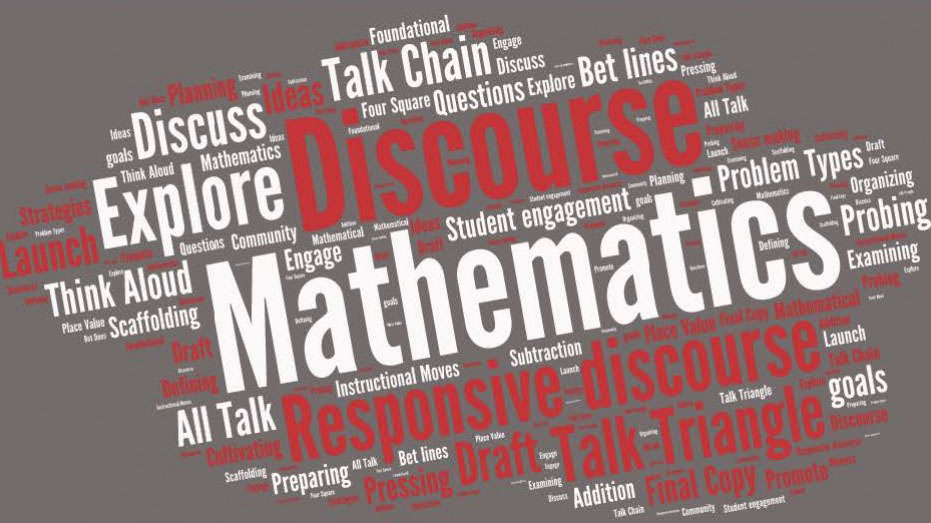Learning Math Through Language
NC State College of Education

The importance of talk for learning takes center stage in the classroom. But not all talk matters, and bringing the kind of conversation that promotes understanding into the classroom remains challenging for teachers across the nation – particularly in mathematics! That concept drives Project AIM: All Included in Mathematics.
Launched in 2010 with a $2.9 million grant from the National Science Foundation, this five-year project aimed to promote productive mathematics talk through offering teachers a set of strategies they could immediately implement with children in their classrooms.
“When project AIM started, our initial design assumptions were that young children actually needed to be taught how to talk in math, that there were interesting strategies to support talk in elementary classrooms already being used for literacy instruction, and that we could translate these strategies into math to support elementary teachers,” said Dr. Paola Sztajn, head of the College of Education’s Department of Teacher Education and Learning Sciences and Principal Investigator for Project AIM.
For the next five years, Sztajn worked with colleagues at NC State, Horizons Research Inc., and Wake County Public School System to develop and test a professional development program that successfully supported teachers in promoting mathematics discourse among their students. Working with more than 200 teachers and 15 math coaches, the team engaged in four year-long design cycles in which they carried out, researched, and refined the program to show that participating teachers can learn to implement productive math discourse and realize the content demand such discourse imposes. After all, to be able to ask the right question at the right time and to help young children share their mathematical ideas, teachers need to know their math in depth.
The results of Project AIM quickly showed the power of the set of strategies teachers brought to their practice. “Many professional development programs in mathematics focus on helping teachers understand the theoretical principles that connect talk and learning. Our program is different: we decompose practice and give teachers well-specified techniques they can immediately put to use; and as teachers see their own children engaging in some pretty cool math conversations, we help them reflect on what is happening in their classrooms to discuss the theory behind it,” explained Sztajn.
Teachers, math coaches and principals who were part of Project AIM have all lauded the program. Carol Mohn, an instructional resource teacher at Baileywick Road Elementary School in Raleigh, experienced firsthand the results of Project AIM’s innovative methods. She saw teachers strengthen their classroom leadership by helping students engage in conversations on how they solved math problems.
“Students were confident because teachers were more confident in their teaching. The children now have a greater mathematical concept understanding,” said Mohn.
Camille Miller, a principal at Willow Springs Elementary School in Willow Springs, North Carolina, echoes those sentiments. “They [the students] more deeply understand mathematics as opposed to just learning a formula or set of steps,” she said.
The success teachers and principals experienced was also demonstrated through several pre- and post-treatment assessments used in the project. Sztajn and her team showed that participating teachers significantly increased their knowledge of math and also changed their beliefs and practices in teaching mathematics. The team used this set of results to secure a new $2 million grant from NSF in the fall of 2015.
In this new four-year research program, Sztajn and her partners at Horizon Research Inc. will work with a new partner district. Over the years, as Project AIM researchers worked with several math coaches who implemented the program, they examined these coaches’ facilitation moves and what they needed to implement the program with fidelity.
They then used the results of this research to create an online learning system designed to allow facilitators – who were not part of the program development and who are not working directly with the research and development team – to implement Project AIM. The goal of the new grant is to show that Project AIM professional development program, through its learning system, is scalable and impacts not only participating teachers but also their students.
Given the paucity of research actually connecting professional development all the way to student learning, the team is now confronted with a new challenge. “We want to connect the other piece of the puzzle,” said Sztajn. “With the first grant, we connected the professional development to teacher change. Now, with the second grant, we want to connect these changes in teachers to student learning, particularly for English learners who will learn how to talk math with their colleagues in their classrooms.”
Sztajn suggested that the Project AIM program can help teachers achieve more equitable classroom instruction, where all students are included in math conversations, regardless of background or learning ability. The implementation of the program in a district with high numbers of English learners will allow the team to test this hypothesis. With greater equity in the classroom, more students can gain the confidence needed to succeed in math.
“At every level, we need to have teachers who can engage all kids and help them talk about math in ways that are productive,” Sztajn concluded. “If we manage to get every student to start talking this way about math early on in school, they will carry it with them throughout their school career and beyond.”